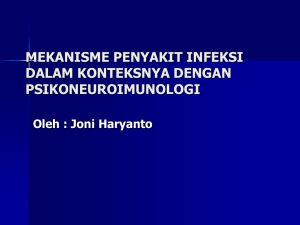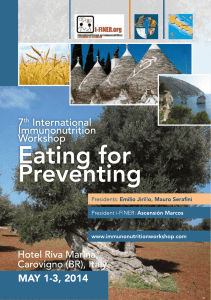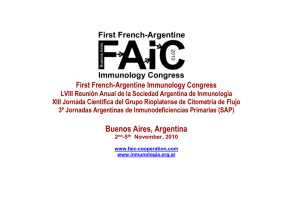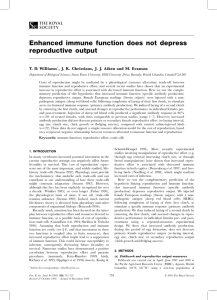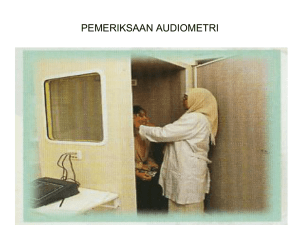vi Sistem Kebal Buatan (SKB) merupakan suatu paradigma yang agak naif
advertisement
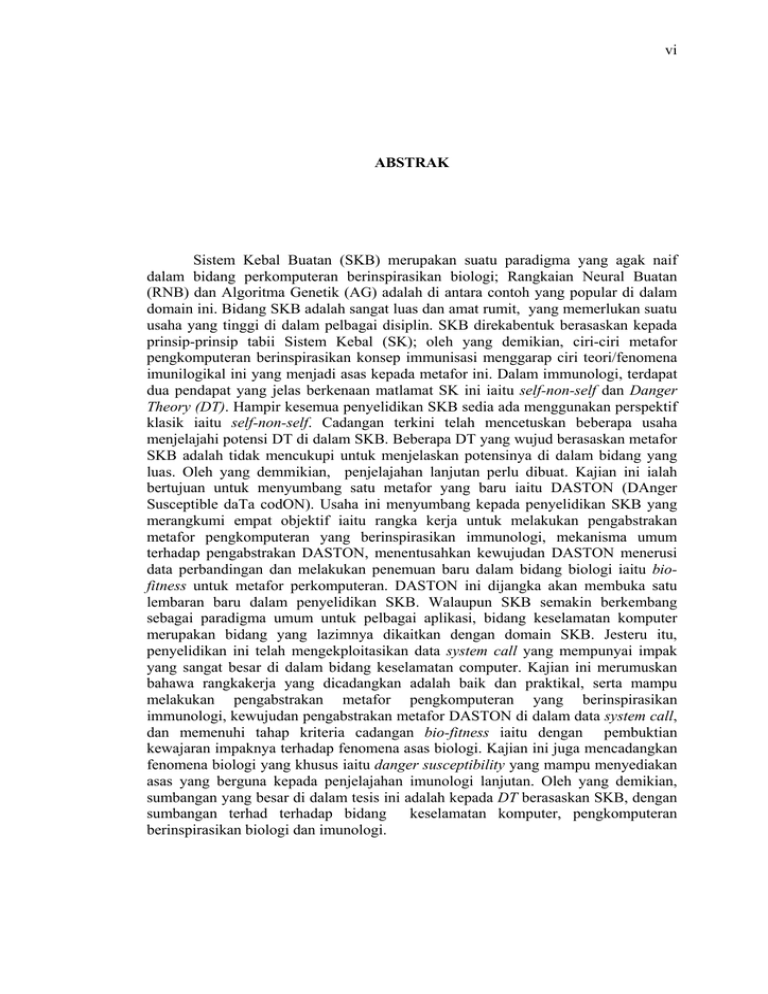
vi ABSTRAK Sistem Kebal Buatan (SKB) merupakan suatu paradigma yang agak naif dalam bidang perkomputeran berinspirasikan biologi; Rangkaian Neural Buatan (RNB) dan Algoritma Genetik (AG) adalah di antara contoh yang popular di dalam domain ini. Bidang SKB adalah sangat luas dan amat rumit, yang memerlukan suatu usaha yang tinggi di dalam pelbagai disiplin. SKB direkabentuk berasaskan kepada prinsip-prinsip tabii Sistem Kebal (SK); oleh yang demikian, ciri-ciri metafor pengkomputeran berinspirasikan konsep immunisasi menggarap ciri teori/fenomena imunilogikal ini yang menjadi asas kepada metafor ini. Dalam immunologi, terdapat dua pendapat yang jelas berkenaan matlamat SK ini iaitu self-non-self dan Danger Theory (DT). Hampir kesemua penyelidikan SKB sedia ada menggunakan perspektif klasik iaitu self-non-self. Cadangan terkini telah mencetuskan beberapa usaha menjelajahi potensi DT di dalam SKB. Beberapa DT yang wujud berasaskan metafor SKB adalah tidak mencukupi untuk menjelaskan potensinya di dalam bidang yang luas. Oleh yang demmikian, penjelajahan lanjutan perlu dibuat. Kajian ini ialah bertujuan untuk menyumbang satu metafor yang baru iaitu DASTON (DAnger Susceptible daTa codON). Usaha ini menyumbang kepada penyelidikan SKB yang merangkumi empat objektif iaitu rangka kerja untuk melakukan pengabstrakan metafor pengkomputeran yang berinspirasikan immunologi, mekanisma umum terhadap pengabstrakan DASTON, menentusahkan kewujudan DASTON menerusi data perbandingan dan melakukan penemuan baru dalam bidang biologi iaitu biofitness untuk metafor perkomputeran. DASTON ini dijangka akan membuka satu lembaran baru dalam penyelidikan SKB. Walaupun SKB semakin berkembang sebagai paradigma umum untuk pelbagai aplikasi, bidang keselamatan komputer merupakan bidang yang lazimnya dikaitkan dengan domain SKB. Jesteru itu, penyelidikan ini telah mengekploitasikan data system call yang mempunyai impak yang sangat besar di dalam bidang keselamatan computer. Kajian ini merumuskan bahawa rangkakerja yang dicadangkan adalah baik dan praktikal, serta mampu melakukan pengabstrakan metafor pengkomputeran yang berinspirasikan immunologi, kewujudan pengabstrakan metafor DASTON di dalam data system call, dan memenuhi tahap kriteria cadangan bio-fitness iaitu dengan pembuktian kewajaran impaknya terhadap fenomena asas biologi. Kajian ini juga mencadangkan fenomena biologi yang khusus iaitu danger susceptibility yang mampu menyediakan asas yang berguna kepada penjelajahan imunologi lanjutan. Oleh yang demikian, sumbangan yang besar di dalam tesis ini adalah kepada DT berasaskan SKB, dengan sumbangan terhad terhadap bidang keselamatan komputer, pengkomputeran berinspirasikan biologi dan imunologi. vii TABLE OF CONTENTS CHAPTER 1 TITLE PAGE DECLARATION ii DEDICATION iii ACKNOWLEDGEMENTS iv ABSTRACT v ABSTRAK vi TABLE OF CONTENTS vii LIST OF TABLES xii LIST OF FIGURES xiv LIST OF ABBREVIATIONS xix LIST OF APPENDICES xxi INTRODUCTION 1 1.1 Introduction 1 1.2 Artificial Immune System Overview 2 1.3 Distinct Approaches in Artificial Immune System Research 4 1.4 Need for Danger Theory based AIS Metaphors 5 1.5 Research Goal and Objectives 7 1.6 Research Motivation 8 1.7 Research Contributions 10 1.8 Thesis Organization 11 1.9 Summary 12 viii 2 NATURAL IMMUNE SYSTEM AND DISTINCT VIEWPOINTS 13 ABOUT ITS MAIN GOAL: SELF-NON-SELF AND DANGER THEORY 2.1 Introduction 13 2.2 Overview of Natural Immune System 14 2.2.1 The Immune System Cells 16 2.2.1.1 Lymphocytes 17 2.2.1.2 B Cells and Antibodies 17 2.2.1.3 T Cells and Lymphokines 18 2.2.1.4 Natural Killer Cells 18 2.2.1.5 Phagocytes, Granulocytes and Their Relatives 19 2.3 2.4 3 2.2.2 The Complement System 19 2.2.3 Binding of Lymphocyte with Antigen 20 2.2.4 Mechanisms of Cell Death 20 2.2.5 Innate Immune System 21 2.2.6 Adaptive Immune System 23 2.2.7 The MHC Complex 24 2.2.8 Complete Picture of the Immune System Process 25 Distinct Viewpoints about the Main Goal of Immune System 27 2.3.1 Self-Non-Self Viewpoint 28 2.3.2 Danger Theory Viewpoint 31 2.3.3 Deep Shifts in Immunology Concepts 33 Summary 34 ARTIFICIAL IMMUNE SYSTEMS AND DANGER THEORY 35 3.1 Introduction 35 3.2 Principles for an Artificial Immune System 36 3.3 Self-Non-Self Based Artificial Immune Systems 39 3.3.1 40 General Principle of Self-Non-Self Based Artificial Immune Systems 3.3.2 An Example of Artificial Immune System for Intrusion 41 Detection 3.4 Recommendation for Danger Theory 44 3.5 Pioneering Efforts in Danger Theory based AIS Research 46 ix 3.6 3.7 4 3.5.1 Intrusion Detection 47 3.5.2 Sparse Distributed Memories 47 3.5.3 Web Mining 48 3.5.4 Misbehaviour Detection in Ad-Hoc Networks 49 3.5.5 Algorithm for Anomaly Detection 50 3.5.6 T-Cell Inspired Algorithm CARDINAL 50 3.5.7 Growing Tissue for AIS 51 3.5.8 Danger Susceptibility Metaphor 52 Survey of Artificial Immune System Applications 53 3.6.1 Computer Security 53 3.6.2 Some Other Potential Application Domains 55 Summary A FRAMEWORK FOR IMMUNE INSPIRED METAPHOR 56 58 ABSTRACTION 4.1 Introduction 58 4.2 General Research Framework 59 4.3 Motivation for the Framework 60 4.4 Framework for Metaphor Abstraction 63 4.4.1 64 Seeking Interdisciplinary Knowledge of Immunology and Computation 4.4.2 Seeking Knowledge about Existing Artificial Immune 65 Systems 4.4.3 Developing Analogies between Computational and 67 Immune Systems 4.5 4.4.4 Extracting Closely Analogous Subsystems 67 4.4.5 Abstracting Metaphor 68 4.4.6 Testing and Validation for Metaphor 70 4.4.7 Bio-Fitness of a Computational Metaphor 71 4.4.8. Refining the Metaphor 72 Framework for Abstracting DASTON 72 4.5.1 73 Seeking Interdisciplinary Knowledge of Immunology and Computation x 4.5.2 Seeking Knowledge about Existing Artificial Immune 74 Systems 4.5.3 Developing analogies between computational and immune 74 systems 4.6 5 4.5.4 Extracting closely analogous subsystems 74 4.5.5 Abstracting Metaphor 75 4.5.6 Testing and Validation for DASTONs 75 4.5.7 Bio-Fitness of DASTON 76 Summary ABSTRACTING DANGER THEORY INSPIRED 76 78 COMPUTATIONAL METAPHOR: DANGER SUSCEPTIBLE DATA CODON (DASTON) 5.1 Introduction 5.2 Overview of the Process for Metaphor Abstraction 79 5.3 Identification of Basis Mechanisms 80 5.3.1 Proposed Biological Mechanism “Danger Susceptibility” 80 5.3.2 Basis Computational Mechanism 82 5.4 Developing Theoretical Background 6 78 84 5.4.1 Overview of Genetics and Proteomics 84 5.4.2 Genetic Susceptibility for Infectious Disease 86 5.4.3 The Danger Theory in Genetics Context 90 5.5 Logical Mapping for DASTON 92 5.6 Summary 95 EXISTANCE OF “DASTON” IN SYSTEM CALL DATA 96 6.1 Introduction 96 6.2 Identification of DASTON 97 6.3 System Calls Overview 98 6.3.1 Operating System Architecture 98 6.2.2 System Calls Process 100 6.4 6.5 Significance of System Calls Data in Computer Security 102 6.4.1 103 Survey of Related Work The University of New Mexico System Calls Bench Mark Data 106 xi 6.6 6.5.1 Overview of Data Generation 106 6.5.2 107 Data File Types Abstraction and Identification of System Call DASTONs 108 6.6.1 Abstraction 109 6.6.2 110 Identification 6.7 Results and Discussion 6.8 7 111 6.7.1 Description of Result Plots and Tables 111 6.7.2 General Discussion 113 6.7.3 Computational Significance 114 Summary “BIO-FITNESS” OF COMPUTATIONAL METAPHOR: 119 120 POLYMORPHISM AND DANGER SUSCEPTIBILITY OF SYSTEM CALL “DASTON” 7.1 Introduction 120 7.2 Defining Biological Fitness of Computational Metaphor 121 7.3 Polymorphism and Susceptibility 122 7.3.1 124 7.4 7.5 7.6 7.7 7.8 Polymorphic Information Content Polymorphism and susceptibility of DATSON 124 7.4.1 The Data Alleles 125 7.4.2 DASTON Associated DATAL 125 7.4.3 Polymorphic Measure of DASTON 126 Bio-Fitness of DASTON 127 7.5.1 128 Identification of DASTALs Bio-Fitness of System Call DASTON 130 7.6.1 Structure of System Call DASTAL 130 7.6.2 Identification of System Call DASTALs 131 Results and Discussion 133 7.7.1 The Result Table 136 7.7.2 Discussion 139 Summary 141 xii 8 CONCLUSION 142 8.1 Introduction 142 8.2 Point of View of This Thesis about AIS Research 142 8.3 Contributions of the Thesis 144 8.3.1 Main Contributions 144 8.3.1.1 144 8.3.2 Framework for Metaphor Abstraction 8.3.1.2 Novel Metaphor “DASTON” 145 8.3.1.3 Mechanism to Prove Existence of DASTON 145 8.3.1.4 Novel Criterion for Metaphor “Bio-Fitness” 146 Partial Contributions 146 8.3.2.1 Significance for Computer Security 147 8.3.2.2 Significance for Immunology and 147 Immuno-Informatics 8.3.2.3 Significance for Biologically Inspired 148 Computation 8.3.3 8.4 Concluding Remarks on Contributions Future Directions 148 149 BIBLIOGRAPHY 151 APPENDIX A 188 APPENDIX B 200 APPENDIX C 203 APPENDIX D 206 xiii LIST OF TABLES TABLE TITLE PAGE 2.1 Comparison of morphological states during cell death 21 5.1 The DASTON abstractions for general processing 94 5.2 The DASTON abstractions for database processing 94 6.1 Sample of system call data 108 6.2 The mapping for system call DASTONs 109 6.3 Significant DASTONs in “sendmail” data 113 6.4 Statistics of different DATONs in “sendmail” experiment 113 6.5 Significant DASTONs in “wu.ftpd” data 116 6.6 Significant DASTONs in “inetd” data 117 6.7 Significant DASTONs in “login” data 118 6.8 Significant DASTONs in “ps” data 119 7.1 Results of experiments for “polymorphic measure” 137 xiv LIST OF FIGURES FIGURE TITLE PAGE 1.1 Research process for biological inspired computation 2 1.2 Research process for immune inspired computation 3 1.3 Two viewpoints about the main goal of immune system 4 2.1 Layered architecture of natural immune system to provide step by step high level defense 14 2.2 Structural view of human immune system and organs involved 15 2.3 Structural division of the cells and secretions of the immune System 2.4 More complementary receptors on lymphocyte have higher affinity for pathogen epitopes and vice versa 2.5 16 20 (a) B-cell recognizing antigen by bonding receptors, which are also called antibodies when in free form, with antigenic apitops, (b) Antigen presenting cell (APC) engulfing antigen, fragmenting into peptides and presenting to T- cell after attaching with Major Histocompatibility Complex (HMC). B-cell also acts as APC in some cases. 22 2.6 Antibody molecule and its genome 23 2.7 Capture, fragmentation, and presentation of a pathogen by antigen presenting cell 25 2.8 Complete picture of immune system process 26 2.9 Primary and secondary response of immune system 27 2.10 Original self-non-self model 28 2.11 Second stage of SNS model 29 2.12 Third stage of SNS model 29 xv 2.13 Fourth stage of SNS model 30 2.14 First stage of danger model 31 2.15 Second view of danger model 32 2.16 Common and difference regions in SNS and danger models 33 3.1 Perfect matching removes the immature detectors that exactly match with self, while imperfect matching might remove the detectors from wide neighborhood. 3.2 Integrated view of negative selection algorithm with clonal Selection algorithm. 3.3 45 The detectors that have previously detected the non-self become memory detectors 3.7 44 The self and non-self share common region to result a blur Boundary 3.6 42 Imperfect matching in negative selection leads to auto-reaction or false positive 3.5 41 Detector generation process for the first generic artificial immune system ARTIS (Hofmeyr and Forrest, 2000) 3.4 38 45 Changing self may overlap the memory detectors, which then detect self as non-self 46 4.1 General framework 59 4.2 Framework for immune-inspired metaphor abstraction 63 4.3 Illustration of the function and analogy of immune system and computer security system 66 4.4 Different subsystems of a natural immune system 68 4.5 Process of negative selection by natural immune system 69 4.6 Illustration of testing and validation process of negative selection 70 4.7 Illustration of sub-framework to test bio-fitness of metaphor 72 4.8 Framework for abstracting novel metaphor DASTON 73 5.1 The immune inspired metaphor abstraction 80 5.2 The danger susceptibility 82 5.3 The mechanism of malicious process generation 83 5.4 The mechanism of query processing 83 5.5 (a) The DNA double helix (linearized schematic), and (b) various regions in a DNA molecule. 84 xvi 5.6 The PrP protein structure 5.7 Mapping biological (immunological) and computational 89 phenomena for DASTON abstraction 92 5.8 Interaction between incident and host data or processes 93 6.1 The flow diagram of algorithm to identify DASTONs 97 6.2 Architecture of an operating system 99 6.3 Operating system managing resources 100 6.4 Traversing from user space to kernel space using system calls 101 6.5 Diagrammatic representation of mapping in Table 6.1 110 6.6 Plot of experiment with “sendmail” system call data 112 6.7 Plot of experiment with “wu.ftpd” data 116 6.8 Plot of experiment with “inetd” data 117 6.9 Plot of experiment with “login” data 118 6.10 Plot of experiment with “ps” data 119 7.1 Framework to test bio-fitness of DASTON 122 7.2 The polymorphic gene locus 123 7.3 The allelic representation of data 125 7.4 Format of DASTON associated data allele 126 7.5 DASTALs to measure polymorphic information content 127 7.6 Process to measure polymorphic information contents and confirm “bio-fitness” of DASTON 7.7 128 Process to measure polymorphic information content of system calls DASTON 129 7.8 DASTON associated data allele for system calls 131 7.9 Complete process of DASTON identification in system call data and confirmation of their “bio-fitness” 132 7.10 Plot presenting “bio-fitness” of “sendmail DASTON” 133 7.11 Plot presenting “bio-fitness” of “wuftpd DASTON” 134 7.12 Plot presenting “bio-fitness” of “inetd DASTON” 134 7.13 Plot presenting “bio-fitness” of “login DASTON” 135 7.14 Plot presenting “bio-fitness” of “ps DASTON” 135 7.15 Plot presenting “bio-fitness” of “lpr DASTON” 136 xvii LIST OF ABRIVIATIONS AIS - Artificial Immune System Ab - Antibody Ag - Antigen APC - Antigen Presenting Cell ANN - Artificial Neural Network ARTIS - Artificial Immune System CDIS - Computer Defense Immune System CD - Compact Disk CM - Computational Metaphor CVIS - Computer Virus Immune System DATAL - Data Allele DASTAL - DASTON Associated Data Allele DATON - Data Codon DASTON - Danger Susceptible Data Codon dsDNA - Double-Stranded DNA DL - DASTON Associated Locus dSOSDM - Dynamic Self Organizing Sparse Distributed Memories CARDINAL - Cooperative Automated worm Response and Detection Immune Algorithm DS - Danger Signal DT - Danger Theory ETDO - Evolutionary Time Dependent Optimization GA - Genetic Algorithm HIS - Human Immune System xviii HLA - Human Leukocyte Antigen ICARIS - International Conference on Artificial Immune Systems ID - Intrusion Detection IDS - Intrusion Detection System INS - Infectious Non Self IS - Natural Immune System / Human Immune System ISS - Information Security System LISYS - Lightweight Intrusion Detection System MHC - Major Histo-compatability Complex MISA - Multi-objective Immune System Algorithm PAMP - Pathogen Associated Molecular Patterns PIC - Polymorphic Information Content PICD - Polymorphic Information Content of DASTON pH - Process Homeostasis PH - Percent Hydrogen PL - Polymorpic Locus PRR - Pattern Recognition Receptor SNP - Single Nucleotide Polymorphism SNS - Self Non Self (SAIS) - Simple Artificial Immune System SOSDM - Self Organizing Sparse Distributed Memories TDO - Time Dependent Optimization TNF - Tumor Necrosis Factor TSP - Traveling Salesman Problem Th - Helper T-Cell Tk - Killer T-Cell xix LIST OF APPENDICES APPENDIX TITLE A System Call Data Files B Establishing Relation between the Polymorphic PAGE 188 Information Content and Allele Frequency 200 C Publications 203 D To Whom Acknowledge 206
